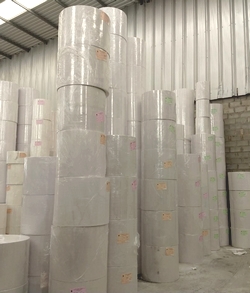The need to improve inventory visibility and thereby speed up control to favor manufacturing planning were key points for a Brazilian papermaking company that has asked not to be identified, which led it to invest in a radio frequency identification system from iTag. Using tags from iTag and readers from Acura, the solution brought improvements to the company’s processes and planning.
Prior to the RFID deployment, control was manual and depended on several workers performing a series of calculations regarding the quantities produced for each paper type, including different weights and sizes, as well as machine efficiency and the specific shift and operator. “We had no estimate of demand for our products, such as surveying our customers’ orders by paper type, weight and quality,” says an executive from the mill, “so there was no possibility of reducing costs through more efficient manufacturing.”
The company’s goal is to produce only what is in demand in the market, based on consumption statistics. “We are currently leveraging our internal and external controls through BI [business intelligence] integrations through the RFID solution,” the representative explains, “which enables extensive data collection and support that ensures cost savings and agility in all processes.”
With the RFID system in place, the company has come to know precisely what is in stock and available for sale at any given moment. “In many cases,” the representative says, “this information depended on checks by a knowledgeable employee in the yard to count the coils. Such a survey could take four to five hours to provide inventory closure.”
The difficulty involved in obtaining information about stocked items can result in chain impacts, such as trouble scheduling the manufacturing of new paper rolls. With the RFID process, the company can monitor the day on a which a particular coil was made, who the machine operator was, the type of paper used, its weight and other variables. All of this information is now stored on smart tags.
Inventory entry and exit is currently RFID-controlled, which has reduced the process of production control by manual tokens. “We now have only one employee responsible for verifying the data and reporting that makes requests for iTag services,” the executive states, “and we have also reduced staff on our expedition, with two operators today.”
RFID processes start with the production of jumbo (“mother”) coils, which give rise to smaller (“daughter”) coils. At this stage, the weighing and filling of all information necessary for internal control are performed. During issuance, the system automatically matches the tags with the parent coils in order to avoid operator errors. With each label issuance, the sales department instantly becomes aware of the existence of a new product in stock, along with its availability, which starts the picking process (the assembly of orders that will pass through the portal before being sent to customers).
After the sorting order has been issued and completed, the goods are released from stock and are thus available for issuing, with invoices and slips created automatically, and with weight and other data filled in, thanks to integration with the RFID system, which ensures the operation’s efficiency and reduces the incidence of errors. “There have been gains in all areas,” the representative reports, “such as people, operations and controls, and we can say that we feel very safe today with the operation, and that RFID did meet expectations.”
The RFID deployment complies with GS1‘s passive EPC UHF standard, which allows users to access product information from anywhere in the world via a tag’s Electronic Product Code. “This facilitates export operations,” the executive notes, “as well as the universal recognition of products by another RFID system, such as a customer.”
An RFID portal has been installed in a project-specific structure with antennas and eight readers, which are evenly distributed between the side brackets. All readers are from Acura, with adhesive tags from iTag containing a Monza R6 chip Impinj. “We use 10,000 labels per month and these are not reused,” according to the company’s representative.



